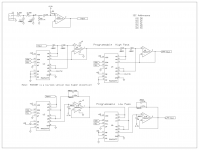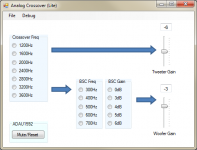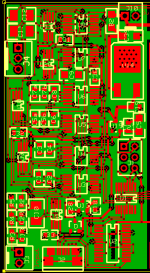Sounds like a job for MiniDSP
Home | miniDSP
This a pair of 2x4 modules and a dual 37V power supply for my Naim preamp.
I run a set of 2 way stand mount speakers and a pair of subs.
They are powerfull and easy to set up, you can tweak and measure in real time if you have a measurement mic setup.
Home | miniDSP
This a pair of 2x4 modules and a dual 37V power supply for my Naim preamp.
An externally hosted image should be here but it was not working when we last tested it.
I run a set of 2 way stand mount speakers and a pair of subs.
They are powerfull and easy to set up, you can tweak and measure in real time if you have a measurement mic setup.
Sounds like a job for MiniDSP.
Agreed, and surprised it took the thread so long to get there.
For a pair of 2-way speakers, a single miniDSP 2x4 is sufficient. I like the balanced one, because it has more output (thus less noise IME) and it's easy and cheap to make RCA adapters to use with unbalanced equipment.
For a more complex system, a 2-channel system could use the 2x8. A multichannel music focused system would be best off with the 8x8, because then you could biamp three 2-way mains, and have two channels for either surround or sub EQ.
How much of an issue would latency be? For instance, if you had your HPF set up as a simple RC filter in the amp to your mid-high speakers, but wanted to use the DSP for the LPF, would the latency on the LFP be noticeable in comparison to the output from the mid-high part of the setup?
I guess you'd need to use the DSP for both the LPF and HPF.
Personally, I'm looking for a way to implement a woofer filter without the large values of capacitance (and possibly inductance) needed in an analog filter. Hence the attraction to DSP. But what of the latency?
--
I guess you'd need to use the DSP for both the LPF and HPF.
Personally, I'm looking for a way to implement a woofer filter without the large values of capacitance (and possibly inductance) needed in an analog filter. Hence the attraction to DSP. But what of the latency?
--
Agreed, and surprised it took the thread so long to get there.
I agree too. Digital crossovers can be very VERY nice but what many people don't realize is that they shouldn't be viewed as a drop-in replacement for an analog, active crossover. To implement them properly you need to restructure your whole sound system around your crossover. Close attention to gain structure becomes much more important with digital crossovers. You need feed the crossover's input with a full un-attenuated signal, then apply attenuation after the crossover outputs, between the x-over outputs and the amplifiers' inputs.(ie. You'll need a 4-gang attenuator for 2-way stereo, 6-gang for 3-way, etc)... .. I currently use miniDSP's 2x8. I absolutely love it, but it rendered my perfectly good preamplifier useless.
Darp
I agree too. Digital crossovers can be very VERY nice but what many people don't realize is that they shouldn't be viewed as a drop-in replacement for an analog, active crossover. To implement them properly you need to restructure your whole sound system around your crossover. Close attention to gain structure becomes much more important with digital crossovers. You need feed the crossover's input with a full un-attenuated signal, then apply attenuation after the crossover outputs, between the x-over outputs and the amplifiers' inputs.(ie. You'll need a 4-gang attenuator for 2-way stereo, 6-gang for 3-way, etc)... .. I currently use miniDSP's 2x8. I absolutely love it, but it rendered my perfectly good preamplifier useless.
While I agree that gain structure is very important for DSP crossovers, I think you're taking it to an extreme. As long as the miniDSP's inputs aren't clipping, you'll be fine. I suppose there may be theoretical benefits to attenuating the post-processed analog output, but it is very much an open question as to whether or not said benefits are audible.
I'll jump in here, I use the cheaper Behringer units and I am am happy with what I get for my dollar.
my Stereo system uses a CX 3400 and my party system uses the smaller and much cheaper CX 2310
Not the best quality and too fiddly to repair but great "bang for buck" and much much cheaper than the passive alternative when you talk about XOs in the low hundreds or high 80s
my Stereo system uses a CX 3400 and my party system uses the smaller and much cheaper CX 2310
Not the best quality and too fiddly to repair but great "bang for buck" and much much cheaper than the passive alternative when you talk about XOs in the low hundreds or high 80s
Good morning.I want ask you,if you have try to replace the cross caps from silver mica or polysterine with caps from polyprop. or oil.Have you hear any differense between them.
While I agree that gain structure is very important for DSP crossovers, I think you're taking it to an extreme. As long as the miniDSP's inputs aren't clipping, you'll be fine. I suppose there may be theoretical benefits to attenuating the post-processed analog output, but it is very much an open question as to whether or not said benefits are audible.
I agree with this. Definitely nothing wrong with attenuating the signal before DSP, regardless what the theory may say.
At $99 really not even analog xo can compete with MiniDSP, value-performance wise.
$99- is what the Behringer 2-way was selling for when I bought mine, then they went up by a hundred dollars when I needed the second
When you've tried bi- or even tri-amping with a decent filter, you'll never go back to passive again.
It simply sounds better. Much, much better.
I was inspired by Rod Elliott and I think his no-nosense writing is what got me on track. After a lot of work with DIY speakers and low-level electronics (preamp / XO) I was in for my first listen. After a couple of seconds of listening I was completely sold on the concept of active crossovers / multiple amps. It literally rocks!
Same here. The way I perceived the difference is that with a non-active system the louder it got, the more it felt as though the audio was being forced out under pressure from two restricted openings (the speakers). There was real effort involved, and subconsciously this was quite tiring to listen to.
When converted to digital active, it feels as though those restrictions have gone, and the entire end of the room is 'the opening' so the music can just pass out (and in, if that makes sense!) unimpeded, at any volume. I realised that I hadn't really understood what 'imaging' was before then.
I have a whole host of new things to tweak: crossover frequency, filter type, filter slope, plus the different permutations of amplifiers I can choose for each type of driver, but I think these are very minor compared to the giant leap of just getting rid of the passive crossover.
Last edited:
I don't agree, especially with HE systems where the modest SNR of the MD could easily be audible.While I agree that gain structure is very important for DSP crossovers, I think you're taking it to an extreme. As long as the miniDSP's inputs aren't clipping, you'll be fine. I suppose there may be theoretical benefits to attenuating the post-processed analog output, but it is very much an open question as to whether or not said benefits are audible.
I use VC after all my DSPs, relay controlled or PGA2310.
I have a whole host of new things to tweak: crossover frequency, filter type, filter slope, plus the different permutations of amplifiers I can choose for each type of driver, but I think these are very minor compared to the giant leap of just getting rid of the passive crossover.
Absolutely agree. I'm new to diyaudio forum - there doesn't seem to be a sub forum of 'loudspeakers' specifically for active speakers (or have I missed something?). The forum we're posting in is meant for passives.
The way I perceived the difference is that with a non-active system the louder it got, the more it felt as though the audio was being forced out under pressure from two restricted openings (the speakers). There was real effort involved, and subconsciously this was quite tiring to listen to.
When converted to digital active, it feels as though those restrictions have gone, and the entire end of the room is 'the opening' so the music can just pass out (and in, if that makes sense!) unimpeded, at any volume. I realised that I hadn't really understood what 'imaging' was before then.
Very true for 99% of mediocre systems. With better systems ("proper" passive crossover, "transparent" amplifications), the number gets smaller.
Best active (should be custom made) versus best passive, I think best active wins, but I don't know why active is not popular. May be because only a few select people are competent for the job (i.e. to do it as easily and as quickly as to do passive).
First of all using XLR connections on the input is no big deal you can just buy adapters.
The adaptors cost me more than the CX2310 did.
Well it can cost a lot more to go active, cost of cables + cost of the second amplifier + cost of the XO itself. Sometimes it simply boils down to affordability.
I went active with a very cheap solution when I costed out the passive crossovers for a second order electric at 120Hz and Behringers came on sale at $99- as I happened to have a spare amplifier. Like Cal; the components to make my cables cost me almost as much as the XO unit but it is still an effective solution, especially for the bass frequencies.
I went active with a very cheap solution when I costed out the passive crossovers for a second order electric at 120Hz and Behringers came on sale at $99- as I happened to have a spare amplifier. Like Cal; the components to make my cables cost me almost as much as the XO unit but it is still an effective solution, especially for the bass frequencies.
Don't get me wrong, it was worth the cost. The adaptors were 13ea. X 14=182 and the CX2310's were 158 for the pair. You can't beat the versatility and they cost less than going passive if you compare oranges to oranges. I recommend that route, it sure saves a lot of time. Heck a lot of us junkies have extra amps gathering dust anyway. 🙂
Who me? Spare amps? Well I have 7 or 8 but none "Spare" The only room in the house that doesn't have its own system is the "Littlest" room.
Besides computers speakers deserve 300 watt amps and multiple dedicated subwoofers don't they?
Besides computers speakers deserve 300 watt amps and multiple dedicated subwoofers don't they?
I prototyped a "different" approach a while back just to see if it would work. It does work just fine, although I haven't taken any measurements or even listened to it critically. It's just standard SK filter topology but with all resistors replaced with digital potentiometers. Unfortunately, the chips are a little pricey, so for what it does there may be better solutions.
The attached schematic doesn't show the microcontroller that provides a USB interface for programming the potentiometers. Also, there is another page of the schematic that isn't shown with BSC and volume controls.
The second attachment shows the GUI for controlling the filters--it works great. Once programmed, the board stays programmed, and the micro will read a pot to control the master volume.
If someone wants to take some measurements on this circuitry I will be happy to ship it off. This circuit hasn't been a priority for me, but I would be interested to see how well it performs.



The attached schematic doesn't show the microcontroller that provides a USB interface for programming the potentiometers. Also, there is another page of the schematic that isn't shown with BSC and volume controls.
The second attachment shows the GUI for controlling the filters--it works great. Once programmed, the board stays programmed, and the micro will read a pot to control the master volume.
If someone wants to take some measurements on this circuitry I will be happy to ship it off. This circuit hasn't been a priority for me, but I would be interested to see how well it performs.



Nope, it's meant for all multi driver speaker systems.The forum we're posting in is meant for passives.
Re: post 38 - why not use DIP switches and put it in your lap whilst programming?
Last edited:
TrueNope, it's meant for all multi driver speaker systems.
Hard to separate sometimes. Lots of us go active in part and passive in part too, as I said earlier, it is hard to beat active for the bottom 3 octaves. I remember a mate getting an active XO for his system back in 1978/79
Phase Linear if my memory hasn't faded, to match his pre-amp and Amcron DC power amps
- Status
- Not open for further replies.
- Home
- Loudspeakers
- Multi-Way
- Active bi-amp - Which electronic crossover?